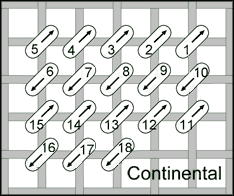Continental stitch on:
[Wikipedia]
[Google]
[Amazon]
Tent stitch is a small, diagonal


 There are three types of tent stitch, all producing the same appearance on the front of the canvas but each worked in a slightly different way and having particular characteristics, uses, benefits and drawbacks. These variants of tent stitch are known as basketweave, continental and half cross tent stitches:
* Basketweave tent stitch
There are three types of tent stitch, all producing the same appearance on the front of the canvas but each worked in a slightly different way and having particular characteristics, uses, benefits and drawbacks. These variants of tent stitch are known as basketweave, continental and half cross tent stitches:
* Basketweave tent stitch
The basketweave form of tent stitch is worked in diagonal rows up and down the canvas. The yarn on the back of the canvas has a typical basketweave appearance, with alternating horizontal and vertical stitches. Basketweave is the best stitch to cover large areas of canvas as it distorts the canvas least and gives the firmest backing to the work, provided it is worked in diagonal rows alternately ascending and descending so that the yarn in ascending rows is laid over warp threads and in descending rows is laid over weft threads:Russell, Beth ''William Morris Needlepoint'' 1995 New York, Crown Publishers, Inc. * Continental tent stitch
Continental stitch is worked horizontally or vertically across the canvas. On the back of the work, the stitches appear diagonally across two threads. This method uses more yarn than half cross stitch tent stitch but is more hardwearing. * Half cross tent stitch
Half cross stitch is worked horizontally or vertically across the canvas. On the back of the work, the stitch appears vertical or horizontal, not diagonal, and crosses only one thread. This method uses less yarn than other stitches but is not very durable as coverage on the back of the canvas is a little thin.
needlepoint
Needlepoint is a type of canvas work, a form of embroidery in which yarn is stitched through a stiff open weave canvas. Traditionally needlepoint designs completely cover the canvas. Although needlepoint may be worked in a variety of stitches, m ...
stitch that crosses over the intersection of one horizontal (weft) and one vertical (warp) thread of needlepoint canvas forming a slanted stitch at a 45-degree angle. It is also known as needlepoint stitch and is one of the most basic and versatile stitches used in needlepoint
Needlepoint is a type of canvas work, a form of embroidery in which yarn is stitched through a stiff open weave canvas. Traditionally needlepoint designs completely cover the canvas. Although needlepoint may be worked in a variety of stitches, m ...
and other canvas work
Canvas is an extremely durable plain-woven fabric used for making sails, tents, marquees, backpacks, shelters, as a support for oil painting and for other items for which sturdiness is required, as well as in such fashion objects as handba ...
embroidery. When worked on fine weave canvas over a single warp and weft thread it is known as petit point in contrast to stitches, such as Gobelin
Gobelin was the name of a family of dyers, who in all probability came originally from Reims, France, and who in the middle of the 15th century established themselves in the Faubourg Saint Marcel, Paris, on the banks of the Bièvre.
The firs ...
, worked over multiple warp and/or weft threads.
"Petit point" comes from the French language, meaning "small point" or "dot".
Tent stitch variants


 There are three types of tent stitch, all producing the same appearance on the front of the canvas but each worked in a slightly different way and having particular characteristics, uses, benefits and drawbacks. These variants of tent stitch are known as basketweave, continental and half cross tent stitches:
* Basketweave tent stitch
There are three types of tent stitch, all producing the same appearance on the front of the canvas but each worked in a slightly different way and having particular characteristics, uses, benefits and drawbacks. These variants of tent stitch are known as basketweave, continental and half cross tent stitches:
* Basketweave tent stitchThe basketweave form of tent stitch is worked in diagonal rows up and down the canvas. The yarn on the back of the canvas has a typical basketweave appearance, with alternating horizontal and vertical stitches. Basketweave is the best stitch to cover large areas of canvas as it distorts the canvas least and gives the firmest backing to the work, provided it is worked in diagonal rows alternately ascending and descending so that the yarn in ascending rows is laid over warp threads and in descending rows is laid over weft threads:Russell, Beth ''William Morris Needlepoint'' 1995 New York, Crown Publishers, Inc. * Continental tent stitch
Continental stitch is worked horizontally or vertically across the canvas. On the back of the work, the stitches appear diagonally across two threads. This method uses more yarn than half cross stitch tent stitch but is more hardwearing. * Half cross tent stitch
Half cross stitch is worked horizontally or vertically across the canvas. On the back of the work, the stitch appears vertical or horizontal, not diagonal, and crosses only one thread. This method uses less yarn than other stitches but is not very durable as coverage on the back of the canvas is a little thin.
References
{{textile arts Embroidery stitches cs:Ruční práce (textil) lt:Rankdarbis pt:Bordado tr:İğne işi